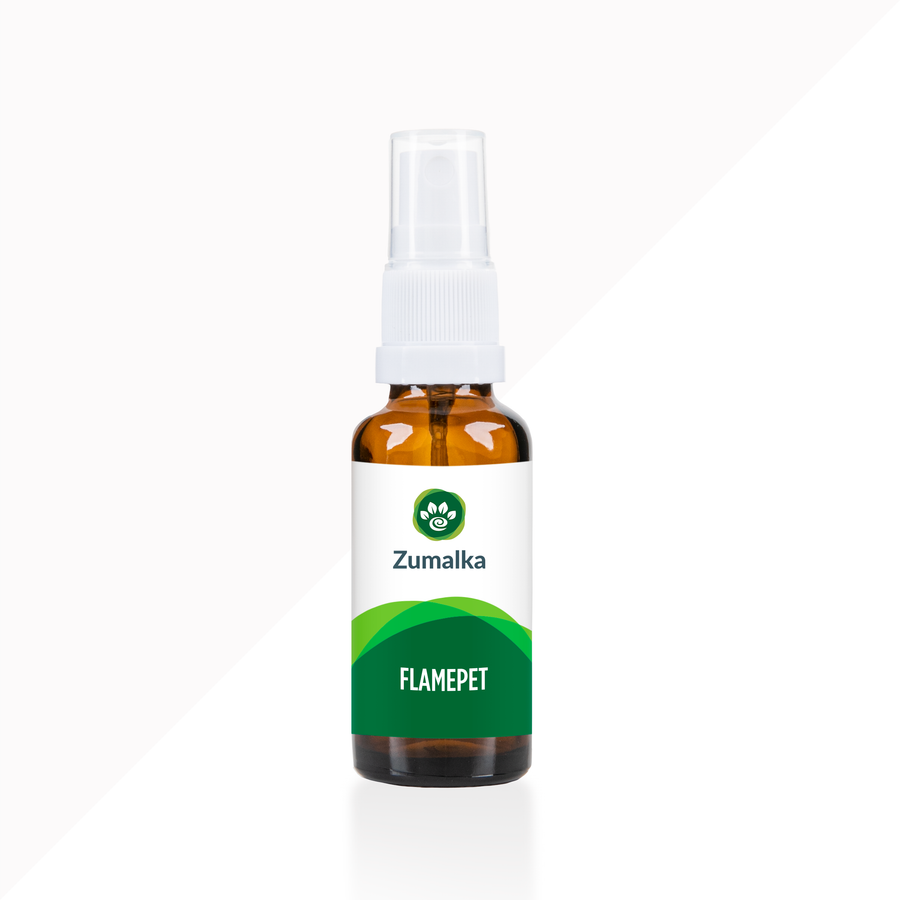9 Best Natural Anti-Inflammatory Foods for Dogs

If you're like most dog parents, you know that your pet can unexpectedly suffer from severe pain and inflammation. Ignoring these health issues can quickly diminish your dog's quality of life.
While many people turn to nonsteroidal anti-inflammatory drugs (NSAIDs) to address this problem, did you know there are actually foods with anti-inflammatory properties that can help manage and treat your dog's pain naturally?
So, without further ado, let's discover some tasty and natural anti-inflammatories for dogs that can help treat pain while giving your pet's taste buds a treat!
Do "Pain" and "Inflammation" Mean the Same Thing?
The short answer is no.
Pain is an unpleasant sensation triggered by receptors in the nervous system. Dogs can experience various types of pain, such as aches, burns, stings, tingles, or pricks.
Depending on the situation, your dog may experience acute pain, which is sharp and short-lived, or chronic pain, which persists intermittently for more than six months, often following conditions like arthritis, orthopedic surgery, or fractures.
Inflammation, on the other hand, is the body’s natural response to illness or injury, initiating the healing process. This response can cause pain, discoloration, or swelling. Depending on the severity, inflammation can result in either acute or chronic pain.
Understanding these concepts is crucial for providing optimal care for your dog, especially when considering natural alternatives to NSAIDs.
Why is it Important to Relieve Pain in Dogs Immediately?
The most significant reason to control pain in dogs immediately is to prevent the problem from worsening. Uncontrolled pain can lead to behavioral changes and physical issues like mobility difficulties and muscle atrophy.
Failing to provide proper pain relief promptly can severely impact your pet's overall quality of life. Remember, the adverse effects of pain are not just physical. They can also be psychological, potentially leading to long-term mental health issues.
Dogs have a very high pain tolerance and may not show any signs of pain until it's too late. This makes it even more challenging to identify when they are suffering. Therefore, regularly consulting your veterinarian or pet wellness expert is crucial to ensure any issues are detected and treated promptly.
Do You Always Need to Use Nonsteroidal Anti-Inflammatory Drugs for Your Dog's Pain?
Interestingly, dogs have natural mechanisms to manage and control pain. However, these mechanisms can be slow to activate, especially in older dogs or those with underlying health conditions, which can hinder the effectiveness of natural pain relief.
Inflammation and pain can often overwhelm dogs, prompting many pet owners to seek immediate relief from their medicine cabinets. This is a common response to alleviate their pets' discomfort quickly.
Unfortunately, over-the-counter NSAIDs, such as meloxicam, aspirin, and ibuprofen, which are formulated for human use, can cause severe side effects in dogs. We will explore these adverse effects in more detail in a later section of our discussion.
Are there any natural anti-inflammatories for dogs?
While nonsteroidal anti-inflammatory drugs (NSAIDs) approved by veterinary medicine are commonly used to manage pain in dogs, there are also natural alternatives that can be just as effective other than those found in your medicine cabinet.
These alternatives can be thought of as "natural NSAIDs" for dogs.
Because they are derived from natural sources, they typically come with fewer serious side effects like liver damage and kidney damage compared to conventional over-the-counter NSAIDs. We will discover these natural alternatives in detail in just a bit.
What are the Causes of Inflammation in Dogs?
Did you know that a dog's body triggers its inflammatory response for various reasons? One common reason is cell damage, which can stimulate the release of an enzyme called cyclooxygenase (COX-1 and COX-2).
These enzymes play a crucial role in the inflammatory process by converting arachidonic acid to prostaglandins, which are compounds involved in inflammation and pain. This process is often referred to as "COX activity."
For this part of our discussion, let's go over some of the common reasons why your dog might be experiencing inflammation.
Increased blood flow in the affected area
While increased blood flow does not cause inflammation by itself, it can indicate that something is wrong with a dog's body, such as injuries like cuts, scrapes, or similar wounds. This increased blood flow, also referred to as "vasodilation," helps deliver immune cells and nutrients to the affected area, aiding in the healing process.
Common indicators of increased blood flow in a specific area of a dog's body include more visible blood vessels, warmth radiating from the area, redness in and around the site, swelling, and increased sensitivity to touch.
Infection
When it comes to pain and inflammation, infection is a very common trigger. This response is typically activated when bacteria, viruses, fungi, or parasites breach the dog's body. These pathogens can enter through ingestion, inhalation, wounds, or other means.
Interestingly, infections are a prime example of when increased blood flow is visibly at work. The body increases blood flow to the affected area through vasodilation to deliver more immune cells, such as dendritic cells and macrophages, to combat the invading pathogens.
Genetics and old age
Inflammation can be triggered independently by genetic factors or aging, meaning each can be a sole cause.
Some dog breeds inherit genetic predispositions that make them more likely to develop inflammation. For instance, Labradors and Golden Retrievers often suffer from joint inflammation due to their susceptibility to hip dysplasia.
Conversely, aging is associated with gradual cell damage and a declining immune response, a process known as "immunosenescence." This can be seen not only in senior dogs but also in other older animals.
Environmental factors
Environmental toxins are not just a human concern. They can significantly impact our pets as well. The most prevalent environmental factors that can trigger inflammation in dogs are toxins and pollutants, such as heavy metals, pesticides, harsh detergents, and industrial cleaning products.
Moreover, exposure to tobacco smoke and emissions from vapes can also make your pet susceptible to respiratory diseases by infiltrating the soft tissue of the lungs and other vulnerable areas.
These chemicals can lead to various health issues in dogs. For instance, they might suffer from gastrointestinal problems like digestive issues and diarrhea. Furthermore, these pollutants can cause more severe side effects, including liver damage and other organ injuries.
Food allergies
There are three important areas to consider when addressing food allergies in dogs: improper immune response, food intolerance, and nutritional imbalance.
An improper immune response occurs when a dog's body mistakenly identifies certain foods as harmful. Common culprits include eggs, soy, wheat, dairy, chicken, and beef, which often cause digestive issues like tummy pain, diarrhea, bloating, and gassiness.
Food intolerance arises when a dog cannot properly process certain foods in the gastrointestinal tract. This condition is common with lactose in dairy products and gluten in wheat, leading to GI tract issues such as bloating, gas, and diarrhea. Your pet may also experience an abnormal influx of gastric acid in these situations, which can further exacerbate digestive discomfort.
Finally, nutritional imbalance occurs with foods that offer little to no nutritional value, typically found in highly processed foods loaded with preservatives, artificial additives, salt, and sugar. These can lead to an increased risk of diabetes and make your dog prone to digestive problems.
Metabolic diseases
Inflammation can be one of the possible side effects if your dog is suffering from metabolic diseases like diabetes, Cushing's disease, kidney disease, obesity, liver disease, or thyroid issues.
To mitigate the effects of these health issues, consider a thorough diet revamp and regular monitoring. Adjusting your dog's diet to reduce inflammation and consistently checking their health status can significantly improve their well-being.
What are the Symptoms of Dog Inflammation?
Below you will find the telltale signs that your dog is experiencing pain and inflammation. I'd like to emphasize that these indicators may vary from one dog to another:
Constant licking of a particular part of the body
Swelling in and around the joint areas, such as the ankles, shoulders, and elbows
- Sudden change in mood
- Lethargy or lack of playfulness
- Stiffness in movement
- Lack of appetite
- Weight loss
- Digestive problems
It is crucial to remember that dogs have a very high pain tolerance and may not exhibit any signs of discomfort. This is why having a general detoxification kit in your pet care checklist is essential. A detoxification kit can help cleanse your dog's system of toxins, potentially reducing inflammation and improving overall health.
Are There Foods That Can Be Used as Anti-Inflammatory for Dogs?
The short answer is yes.
There are natural foods that can help prevent or mitigate the effects of inflammation in your pet's body. In this part of our discussion, we will explore various natural foods such as turmeric, fatty fish, and cayenne pepper, and provide some tips on how to use them effectively.
Let's dive into how these foods can benefit your pet's health.
What are natural anti-inflammatory foods for dogs?
Compared to most NSAIDs for dogs, these natural medications do not contain chemicals that may trigger serious side effects, such as stomach issues, over time. The best part is that you can easily find them in your kitchen or cupboard.
The next time your pet shows signs of pain and inflammation, remember that there are several natural alternatives you can consider. However, I highly recommend consulting with your small animal veterinarian or pet wellness expert before using these options.
#1. Dried comfrey
Traditionally used to ease muscle and joint pains, dried comfrey is now supported by scientific research for its pain-relieving properties. Comfrey contains beneficial compounds such as rosmarinic acid and allantoin, which help mitigate inflammation and promote natural tissue regeneration.
Experts suggest that dried comfrey may offer pain relief comparable to conventional NSAIDs, including ibuprofen, meloxicam, and diclofenac gel, providing a natural alternative for managing discomfort.
To use comfrey as a natural pain medication, combine the dried herb with a small amount of water until it forms a thick paste. Apply the mixture directly to the affected area of the body. In addition to helping control pain, comfrey also helps keep the skin in excellent condition.
To prevent the comfrey from being dislodged or licked off by your dog, wrap the affected area in gauze. Leave the gauze on for a few hours and replace it as soon as the mixture dries out.
#2. Hawthorn berries
Hawthorn berries have traditionally been used to ease pain, reduce inflammation, and address other health issues. Studies reveal that these berries, rich in antioxidants and neolignans, can help relieve stress and prevent liver issues. Their anti-inflammatory action is comparable to many NSAIDs used for dogs.
To use hawthorn berries as an alternative to over-the-counter medication, lightly crush them until the juices are released. Apply the juice liberally to the affected area as a topical ointment for pain relief.
However, while hawthorn berries can provide benefits similar to most NSAIDs and other medications for pain relief, it is crucial to check if your pet is taking medication for hypertension or cardiovascular issues. This is because hawthorn berries can also lower blood pressure while addressing pain and inflammation.
#3. Cayenne pepper
Cayenne pepper not only adds a spicy kick to food but also possesses inflammation-reducing capabilities in both humans and animals. It works by decreasing the "markers" that can trigger or exacerbate inflammation.
Although cayenne pepper does not act as quickly or last as long as other nonsteroidal anti-inflammatory drugs (NSAIDs), it is considered a viable short-term alternative for managing inflammation.
To use cayenne pepper as a natural remedy for your dog's inflammation, mix it with a small amount of vegetable or sunflower oil to create a paste. Gently massage this paste onto the affected area as a topical ointment.
Be extremely careful to avoid contact with your pet's eyes, mouth, and nose, as the spiciness can cause discomfort. To ensure safety, you can wrap the treated area with gauze.
#4: Spirulina
While predominantly known for its antioxidants, studies show that spirulina also provides significant anti-inflammatory benefits by decreasing inflammation markers in the body, such as TNF-α, IL-1β, IL-6, PGE2, and NO.
Additionally, spirulina contains the antioxidant phycocyanin and essential fatty acids like Omega-3 and Omega-6, which help eliminate free radicals that trigger and prolong pain and inflammation.
For pet owners looking to use spirulina as a natural alternative to nonsteroidal anti-inflammatory drugs, you can mix a couple of pinches of this algae into your dog's meal. Alternatively, add a dash of spirulina to your pet's water for the same effect.
#5: Fatty fish
Fatty fish such as sardines, tuna, anchovies, salmon, char, and herring are not only delicious but also packed with eicosapentaenoic acid (EPA) and docosahexaenoic acid (DHA), which have powerful anti-inflammatory properties.
Research indicates that these anti-inflammatory benefits can help alleviate conditions such as rheumatoid arthritis, Crohn's disease, ulcerative colitis, psoriasis, lupus erythematosus, multiple sclerosis, and migraines.
To help manage inflammation-related pain in dogs, consider adding fatty fish like salmon, mackerel, or sardines to your pet's diet. These fish are rich in omega-3 fatty acids, which can help reduce inflammation.
Ensure you cook the fish plainly, without any seasoning, and remove all bones to prevent choking hazards. Grilling, steaming, or baking are the best cooking methods to retain the nutritional benefits. However, always consult with your veterinarian before making any significant changes to your dog's diet.
#6. Turmeric powder
The active ingredient in turmeric powder is a compound called curcumin, which has been found to alleviate health issues such as rheumatoid arthritis, psoriasis, and colitis, among others.
Curcumin works by intercepting pain-signaling molecules in a dog's cells. Additionally, it possesses antioxidant and anti-inflammatory properties similar to those found in over-the-counter NSAIDs.
To use turmeric powder as an alternative to pain medications for your dog, add a pinch or two to their water. You can also mix a small amount with their meals. While turmeric powder is effective for pain relief, be cautious not to add too much, as it can have a peppery bite when ingested in large quantities.
#7. Yucca bark and roots
Research shows that yucca contains a high amount of saponins and polyphenols, compounds known for their ability to suppress the formation of inflammatory agents such as nitric oxide. This root vegetable also improves oxygen circulation, which not only speeds up pain relief but also aids in physical therapy.
To use yucca as a natural alternative to pain medications, clean and lightly mash its bark and roots using a mortar and pestle to form a paste. Apply the mixture directly to the affected area of the dog’s body.
It's crucial to securely wrap the affected area with gauze to prevent your dog from licking the mixture. Reapply once it becomes dry, ideally every few hours or as needed.
Please consult your veterinarian or pet wellness expert before using yucca, as some dogs may have allergic reactions or other side effects.
#8. Cinnamon powder
Cinnamon contains cinnamic acid, a compound known to inhibit the formation of nitric oxide by blocking certain enzymes. Nitric oxide is a well-known inflammatory agent targeted by some FDA-approved NSAIDs.
Furthermore, recent research, including studies from reputable medical journals, indicates that cinnamon may be an effective alternative for managing health issues such as exercise-induced inflammation, osteoarthritis, and rheumatoid arthritis.
To use cinnamon powder as a natural anti-inflammatory for dogs, mix a teaspoon of the spice with a small amount of water to form a paste. For a thicker consistency, add a bit of vegetable oil.
Gently massage the mixture onto the affected area and cover with gauze to hold it in place. You can also add a small amount of cinnamon to your dog's food, but be sure to use Ceylon cinnamon, as Cassia cinnamon can be harmful in large quantities. Remember, cinnamon essential oil can be toxic to dogs.
Consult your veterinarian before using cinnamon, as some dogs may have allergic reactions or other side effects. Apply the paste as needed, and monitor your dog for any adverse reactions.
#9. Ginger
Ginger contains organic substances like shogaol and gingerol that have been found to suppress substances that trigger inflammation in tissues. These compounds are also present in some over-the-counter joint supplements and other medications formulated to manage pain.
To use ginger as an alternative for pain medications, lightly mash a thumb-sized piece in a mortar and pestle to extract the juices. Apply the juice directly to the affected area and cover it carefully with a piece of gauze.
Ensure the gauze is secured tightly so your dog won’t lick the ginger juice, which can be rather spicy for your pet’s taste buds. Apply the ginger juice on the affected area twice daily and leave the gauze on for 30 minutes. Additionally, ginger has been said to have the same effect on osteoarthritis as chondroitin sulfate.
Before using ginger on your pet, consult your veterinarian to ensure it is safe for your dog's specific condition. Monitor the application area for any signs of irritation.
Are Human Anti-Inflammatories Safe for Dogs?
No, human anti-inflammatory medications are not safe for dogs.
Many dog owners mistakenly believe that human NSAIDs can be used for their pets' pain relief. However, this can be extremely dangerous. Human NSAIDs and veterinary NSAIDs are specifically formulated for their respective species and should not be used interchangeably.
Administering human NSAIDs to dogs can result in severe side effects, including gastrointestinal ulcers, kidney damage, and even life-threatening complications.
A Premium Natural Anti-inflammatory for Dogs Designed for Pain Relief
Zumalka's FLAMEPET is specifically designed to promote calm and healthy tissues and skin in your dog. This natural product effectively addresses multiple symptoms often associated with tissue inflammation.
This natural product not only tackles common inflammation symptoms like swelling, pain, bruising, and fevers but also addresses often overlooked signs such as chronic cough, intense thirst, and depression.
If you're searching for a natural, high-quality anti-inflammatory solution to bring comfort to your dog, FLAMEPET is a product worth considering.







Leave a comment